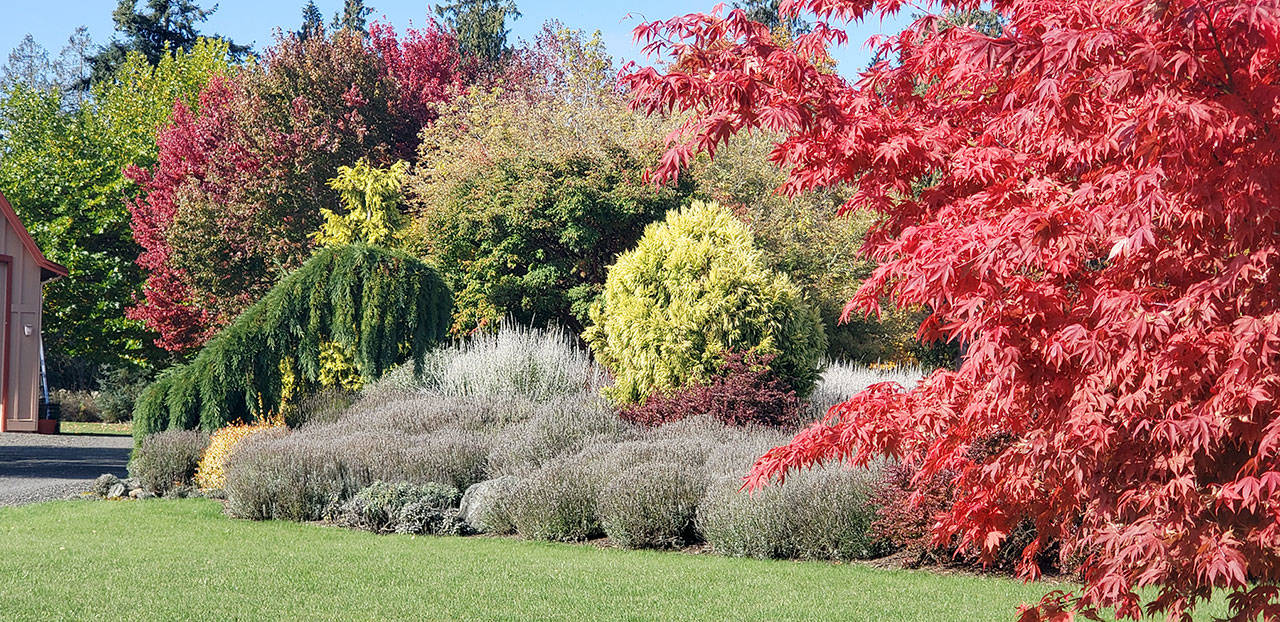EVERY AUTUMN I take a trip to our family cottage on the Wisconsin and Michigan border.
These trips always remind me how utterly beautiful and breathtaking the fall foliage display can be.
And this year’s trip, by far, was no let down.
The golden birches and orange-red sassafras, along with burgundy oaks, amber-hued maples, brilliant red sumac and the various shades of ash trees, were all in dazzling display.
This is precisely why all these plants should be included on your fall list of gorgeous trees to plant.
Planting window
But also, as everyone can see, it appears the rains may now be here to stay awhile, so a huge planting window is upon us.
So to recap and to prove I practice what I preach, let me show you what I am up to now that I, and the moisture, have returned.
First, those spring bulbs — everyone should constantly remember they are the absolute best, most ideally suited plant category for the North Olympic Peninsula. They should be purchased and added.
Plant your bulbs now and continue to buy them now.
You also must apply bone meal or some type of bulb booster fertilizer when planting, as well as every year thereafter.
This is a must.
Also, people almost never plant their bulbs deep enough.
Make sure to dig a deep pit, break up the soil on the bottom, then add your fertilizer and lime as well. Bulbs like soil that is less acidic than ours here on the Peninsula.
Keep in mind that the recommended depth of the bulb is from the top of the bulb, not the bottom. This means if tulips are to be 6 inches deep and the bulb is 1 inch to 1½ inches long, the pit should be 7 to 7½ inches deep. Got it?
Keep in mind that the professionals plant several bulbs together at the same level in the same pit, such as peony flowering tulips.
By mixing early-mid late-blooming tulips (or any others) in the same pit, you will have tulips flower in that same spot for two or three months. How good is that?
Then partially fill up the pit and add, for example, early- and late-flowering crocus at the 2 inch depth for another 2 months of flowers.
One spot with spring flowers from January through May — you cannot beat that.
Nursery stock (trees, bushes and shrubs) is my next big order to arrive — actually, there will be at least three full loads coming to the Peninsula in the next few weeks because, again, now that the rains have arrived there is no better time.
As we know, November is the optimum time.
Mother Nature will water them in for you, and next summer, they will be firmly rooted in.
As always, fertilize well both the bottom of the hole and then again atop the soil. Here too, bone meal is the miracle drug.
Buy it in bulk and spread it very liberally.
You really can’t overdo it with bone meal.
Water it in
Regardless of how hard it is or has been raining, always water in freshly planted nursery stock extremely well, preferably numerous times that first day, then cover with a very thick layer of mulch, 6 to 12 inches. This, too, is mandatory.
Never, though, have the mulch butt up against the stems, canes or trunks of your plants, or this could actually kill or harm the plant over time.
But do bring the mulch up close and include at least one gorgeous fall foliage plant.
Then your lawn will be a prime area of concern and workload.
Several bags of high-quality grass seed already have been delivered to me for projects here on the Peninsula.
High quality grass seed is measured by very low weed content, which is less than 1 percent — I prefer 0.001 percent or less weed seed — and high germination, 82 percent or greater, 90 percent if possible.
Absolutely lime your lawn now as well, and after fall fertilizer applications are a must, too.
The suggestion is to lime and fertilize now, today, this week, then at the end of the month or early November, spread the grass seed over your lawn.
The best lawns are over-seeded every fall and spring.
If you need to, aerate and de-thatch first, then lime, fertilize and lay down grass seed for the perfect lawn.
There you go.
Join me in November — let’s plant like little maniacs for a gorgeous next year, but to do so you must make plans and order supplies in the next 10 days.
________
Andrew May is a freelance writer and ornamental horticulturist who dreams of having Clallam and Jefferson counties nationally recognized as “Flower Peninsula USA.” Send him questions c/o Peninsula Daily News, P.O. Box 1330, Port Angeles, WA 98362, or email news@peninsuladailynews.com (subject line: Andrew May).

